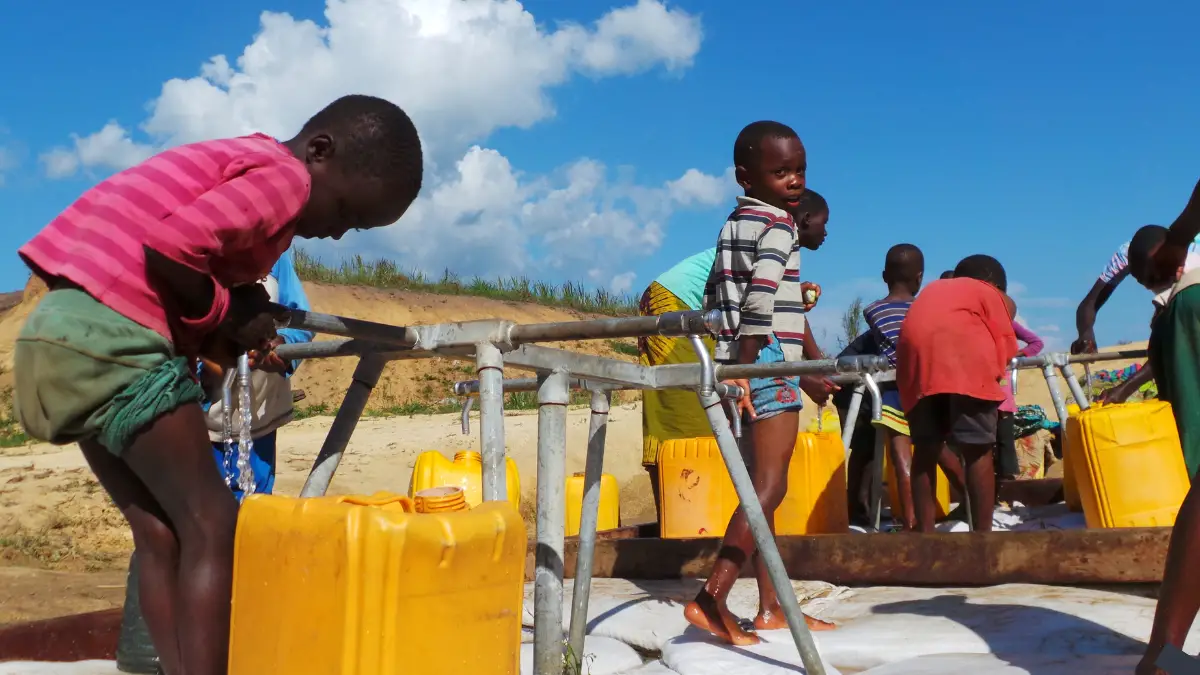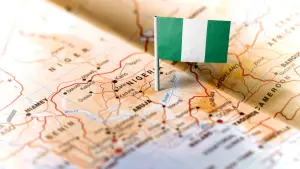The heat season in Nigeria this year has been severe. Many regions of the country witnessed temperatures as high as 47 degrees Celsius. Some elderly people reported this season to be the hottest they have experienced in their over 60 years of living. The heatwave prompted the country’s weather agency to publish regular advisories.
It can be said that the heat is more noticeable because it coincided with the Muslim’s fasting of Ramadan. But records show that there is more to the heat than just that. Last year, an essay discussed how the month of January was hot instead of the usual harmattan.
The bottom line is that our climate is changing and our earth is heating up. While the heating up of the earth causes the melting of ice and rise in ocean levels, it is at the same time causing the shrinking of fresh water bodies.
The heat season in Nigeria is a time when severe water scarcity is recorded. Wells dry up, ponds become dead clay and river levels shrink. The shrinking of Lake Chad perfectly captures the extent of the problem. The lake is reported to have lost 90% of its water over the past 40 years.
This problem of water scarcity persists despite our technological advancements and progress in many parts of the world. Developing and undeveloped cities are mostly at the end of this problem.
It is therefore, the aim of this essay to look into the challenges faced by communities in accessing water; explores the human activities contributing to water scarcity; discusses practical adaptation strategies, and provides policy recommendations for effective water management in our communities.
Challenges of Water Scarcity
In various regions, especially in developing countries, the struggle for water is dire. Communities, particularly those marginalized by poverty, travel long distance to fetch water or resort to purchasing it from vendors at exorbitant prices.
Below are some factors that contribute to water scarcity problems in poor communities:
1. Infrastructure Deficiencies: Inadequate infrastructure in poor communities hampers access to clean water. Lack of piped water systems, water treatment plants, and storage facilities make it even more difficult for communities to access safe and reliable water sources.
Rural areas, in particular, suffer from underdeveloped infrastructure, forcing residents to rely on contaminated sources such as rivers, ponds, or open wells, which pose serious health risks.
2. Inequitable Distribution: Water scarcity often exacerbates existing social inequalities, with marginalized communities bearing the brunt of water shortages.
In urban areas, informal settlements or slums are disproportionately affected. This is because they are often excluded from municipal water supply networks. As a result, residents, primarily women and children, are forced to spend significant time and effort to collect water. This limits their opportunities for education, employment, and economic empowerment.
3. Financial Constraints: For those living in poverty, it remains a barrier to accessing water. Even when water is available through centralized systems, high tariffs or connection fees may render it unaffordable to them. Consequently, they resort to purchasing water from informal vendors at inflated prices. Or digging local wells to drink from. This poses threats to their health and makes them vulnerable.
4. Climate Variability and Natural Disasters: Climate change causes change in rainfall patterns and extreme weather events. For example, droughts, floods, and hurricanes disrupt water supply systems, damage infrastructure, and contaminate water sources. Furthermore, the increased frequency and intensity of such events pose challenges for water management and adaptation strategies.
5. Water Pollution and Contamination:
Industrial discharge, agricultural runoff, and improper waste disposal contribute to the pollution of water sources. Contaminated water poses serious health risks, leading to waterborne diseases such as cholera, typhoid, and diarrhea, particularly in communities with limited access to sanitation and hygiene facilities
6. Conflict and Political Instability:
In regions plagued by conflicts or wars, access to water is a matter of survival. Competition over limited water resources escalates into conflicts between communities, ethnic groups, or even nations. This is true in places like Gaza, South Sudan, Democratic Republic of Congo and some parts of Maiduguri. Also, the destruction of water infrastructure during conflicts further compounds water scarcity, hindering recovery and reconstruction efforts.
Causes of Water Scarcity
Human activities play a significant role in the depletion and degradation of water sources.
This section takes a look at some of the human activities that contribute to water scarcity problems.
1. Population Growth: The global population continues to expand rapidly. Rapid population growth in regions already facing water stress exacerbate the demand for water for domestic, industrial, and agricultural purposes. As population density increases, competition for water resources intensifies, leading to overexploitation and depletion of available water sources.
2. Unsustainable Agricultural Practices: Agriculture accounts for a significant portion of water usage worldwide. However, inefficient irrigation methods, excessive water withdrawals, and monoculture farming practices contribute to the depletion of aquifers and surface water bodies. Furthermore, the use of chemical fertilizers and pesticides contaminates water sources, further exacerbating water scarcity and environmental degradation.
3. Deforestation and Land Degradation: Deforestation, primarily driven by agricultural expansion, logging, and urbanization, disrupts ecosystems and alters water cycles. Forests play a crucial role in regulating rainfall patterns, reducing soil erosion, and replenishing groundwater supplies. Deforestation leads to soil erosion, sedimentation of rivers and reservoirs, and loss of biodiversity, thereby reducing the capacity of ecosystems to sustainably manage water resources.
4. Industrialization and Urbanization: Rapid industrialization contributes to water scarcity through increased water demand, pollution, and habitat destruction. Industrial activities such as mining, manufacturing, and energy production require large volumes of water for cooling, processing, and waste disposal. Urbanization leads to the expansion of impervious surfaces, reducing infiltration and recharge of groundwater aquifers and increasing the risk of flooding and water pollution.
5. Over-Extraction of Groundwater: Groundwater, a vital source of drinking water and irrigation, is being overexploited in many regions. This leads to groundwater depletion and saltwater intrusion in coastal areas. Unregulated pumping, particularly for agricultural irrigation and urban water supply, exceeds natural recharge rates, causing groundwater levels to decline steadily. The depletion of aquifers not only reduces water availability but also exacerbates land subsidence and threatens the sustainability of ecosystems dependent on groundwater resources.
Strategies to Adapt to Water Scarcity
Communities facing water scarcity must adopt sustainable practices to mitigate its impact. Rainwater harvesting, water conservation measures, and efficient irrigation techniques offer viable solutions to enhance water resilience.
Here are some ways through which communities can adapt to the problem of water scarcity:
1. Promoting Water Conservation Practices: Communities can implement water-saving measures at the household level, such as fixing leaks, installing water-efficient appliances, and practicing water-wise gardening techniques. Educational campaigns and outreach programs can raise awareness about the importance of water conservation and provide practical tips for reducing water usage.
2. Implementing Water Reuse and Recycling: Wastewater recycling and reuse initiatives can help alleviate water scarcity by treating and repurposing wastewater for non-drinking purposes such as irrigation, industrial processes, and landscape irrigation. Greywater systems, which capture and treat wastewater from sinks, showers, and laundry, can be integrated into residential and commercial buildings to reduce reliance on freshwater sources.
3. Investing in Rainwater Harvesting: Rainwater harvesting systems capture and store rainwater for later use, providing a sustainable source of water for irrigation, toilet flushing, and other non-potable applications. Communities can incentivize the installation of rainwater harvesting systems in homes, schools, and public buildings to augment water supplies during dry periods and reduce reliance on groundwater and surface water sources.
4. Adopting Drought-Resistant Crops and Farming Practices: In agricultural communities, shifting to drought-resistant crop varieties and implementing water-efficient farming techniques can help mitigate the impacts of water scarcity. Practices such as drip irrigation, mulching, and soil conservation can improve water-use efficiency, reduce irrigation demand, and enhance crop resilience to drought conditions.
5. Promoting Community-Based Water Management: Engaging local communities in participatory water management initiatives fosters collective decision-making, builds resilience, and strengthens social cohesion. Community-based water management approaches empower residents to identify water-related challenges, develop innovative solutions, and implement sustainable water management practices tailored to local needs and conditions.
6. Investing in Water Infrastructure and Technologies: Investing in water infrastructure upgrades, such as leak detection and repair, pipeline rehabilitation, and water treatment facilities, can improve the efficiency, reliability, and safety of water supply systems. Deploying advanced technologies, such as smart meters, remote sensing, and predictive analytics, can optimize water distribution, reduce losses, and enhance water resource management.

Policy Recommendations for Water Management
Effective water management is crucial for sustainable development and the well-being of communities. Here are some policy recommendations:
1. Integrated Water Resource Management (IWRM): Implement a comprehensive approach that considers the interconnectedness of water resources, including surface water, groundwater, and water quality, to ensure sustainable and equitable use.
2. Water Governance Reform: Enhance governance structures to promote transparency, accountability, and stakeholder participation in decision-making processes related to water management. This could involve decentralization, community involvement, and capacity building.
3. Water Pricing and Subsidy Reform: Establish water pricing mechanisms that reflect the true cost of water, including infrastructure maintenance, environmental externalities, and scarcity. Targeted subsidies can be provided to ensure affordability for low-income households.
4. Climate Change Adaptation Strategies: Develop and implement adaptation strategies to address the impacts of climate change on water resources, such as increased variability in precipitation patterns, more frequent droughts, and sea-level rise. This may include measures like watershed management, floodplain zoning, and infrastructure resilience planning.
5. Ecosystem Protection and Restoration: Prioritize the protection and restoration of aquatic ecosystems, which provide essential services such as water purification, flood regulation, and habitat for biodiversity. This could involve establishing protected areas, restoring wetlands, and implementing sustainable land-use practices.
6. Water Infrastructure Investment: Increase investment in water infrastructure, including storage facilities, treatment plants, distribution networks, and wastewater management systems, to ensure reliable and safe water supply for all communities.
Conclusion
Water scarcity poses a threat to human well-being, environmental sustainability, and economic prosperity. Addressing this complex challenge requires concerted efforts from governments, communities, and stakeholders across sectors.
By understanding the root causes of water scarcity, implementing adaptation strategies, and enacting sound water management policies, we can ensure access to clean and reliable water for present and future generations.
Let us commit to preserving this precious resource, safeguarding the health and prosperity of communities worldwide.





